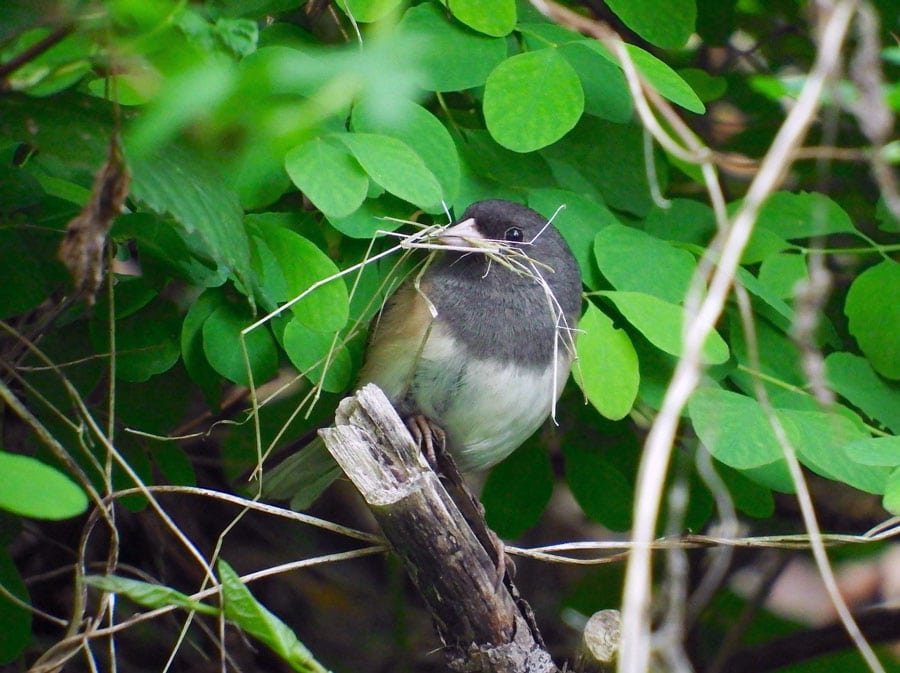
Springtime comes to the peninsula. The soil warms and bird songs light up the mornings. In the forest you no longer tramp recklessly through the underbrush, for everywhere grow the nearly translucent shoots of newly emerging plants.
I weed a row of the tiniest mustard greens, thinking I should perhaps have brought tweezers and wondering how these dewdrop-sized leaves will become something to eat, when a junco appears. Like a windup toy it hops through a nearby garden bed with dried grass in its pink beak. It takes a look around and disappears into the bed’s end board. A moment later it reappears, its beak empty, and flies to a cedar.
The end board is half-rotten, the bed still full of weeds. Planting stakes lie where they have lain since last fall. It takes a good bit of crouching and peering before I find, in a hollow in the board, the nest within, a perfect flaxen bowl of grass nearly finished.
Looking into a bird’s nest has always felt like finding someone’s open diary. Its owner might not want you there — the killdeer drags its wing as if broken, the blackbird dives at your head like a kamikaze — yet when it sees that you have no intention of wrecking what it has built, it calms. It watches you looking. There is a fleeting moment of trust.
A nest is pure vulnerability. Soon you know you must pull back. To overstay the intimacy would be callous. I move away and the junco soon returns. Within days it will lay its clutch of eggs.
We humans love springtime for the new life it brings in abundance. We interpret it as a season of brightness, curiosity and joy. Yet as I squat alongside my mustard greens and the junco, it is hard not to wonder at the fragility of it all. In the forest, plant shoots are the choicest snack for passing deer. One bite kills them. One footstep. The deer itself has babies so vulnerable they survive by stillness and lack of scent. This world is often rough, that we know. How does anything survive when it must first be so defenseless?
Juncos are one of the most familiar birds in America, and one of the most thoroughly studied by naturalists. Much has been learned about how they nest.
Generally monogamous, juncos return to the same territory year after year. Yet each year, they build a new nest, and the female will often start several before finishing the one in which eggs are ultimately laid. Most nests are built in hollows close to the ground: under a rock, in a root wad, under a fallen trunk. One year a junco dug a nest into a pile of sawdust in our barn. And the nests, so situated, often fail. Male and female junco work together to drive off what chipmunks and snakes they can, yet forces much larger often find them and force them to flee. Though we steered clear of the sawdust nest, it collapsed under the weight of the pile.
Despite their vulnerability — in fact, probably because of it — juncos are exceedingly resilient birds. They will re-nest three, four, even five times over the course of a summer. They try and try again. And this is no small feat. Each egg weighs about 11 percent of the mass of an adult, and each clutch consists of four eggs.
The eggs are incubated for 12 or 13 days. Upon hatching, the chicks can immediately gape and swallow. In three days, they can prop themselves upright. In seven days, their eyes are open. In about 11 days, they fledge. Two weeks after that, at the seasoned age of 25 days, the young juncos fly as skillfully as their parents. And they scatter into the landscape.
I have a filmmaker friend who has begun to pay attention to the birds around him, and recently he found himself standing still while an Anna’s hummingbird flew close. In less than a minute the hummingbird had perched a few feet away.
He told me: “I felt an overwhelming sense of peace. Anxieties fell away. I felt I had a purpose — to see that bird.”
The moment was fleeting. But in that moment, as for the junco and me, and as for every tender life that must sit vulnerably in the world, a wholeness shimmers like sunlight on waves, a pureness of trust. You could call it faith. Because of such moments, life is abundant.
My friend asked, “Is there anything more revolutionary than to be in total peace with a fellow living being, however long it lasts?”
If that is true, spring is the most revolutionary season. And perhaps the juncos in our gardens are its greatest humble prophets.
UNDERWRITTEN BY THE FUND FOR NONPROFIT NEWS (NEWSMATCH) AT THE MIAMI FOUNDATION, THE ANGEL GUILD, ADVERTISERS, DONORS AND PEOPLE WHO SUPPORT INDEPENDENT, NONPROFIT LOCAL NEWS